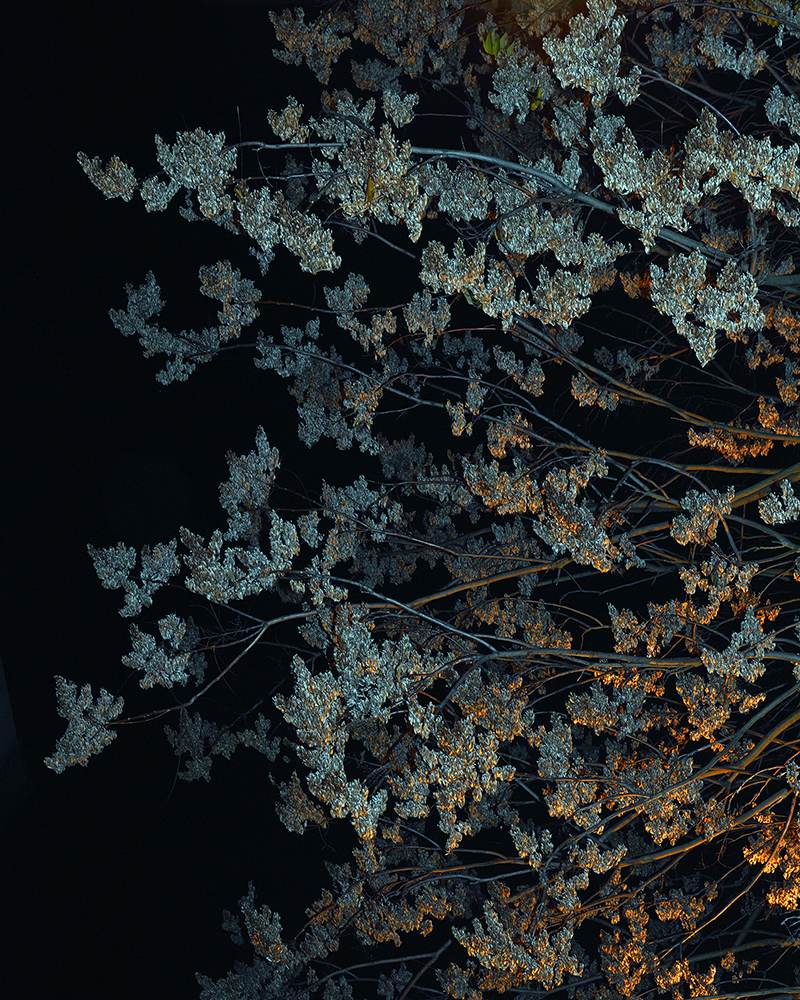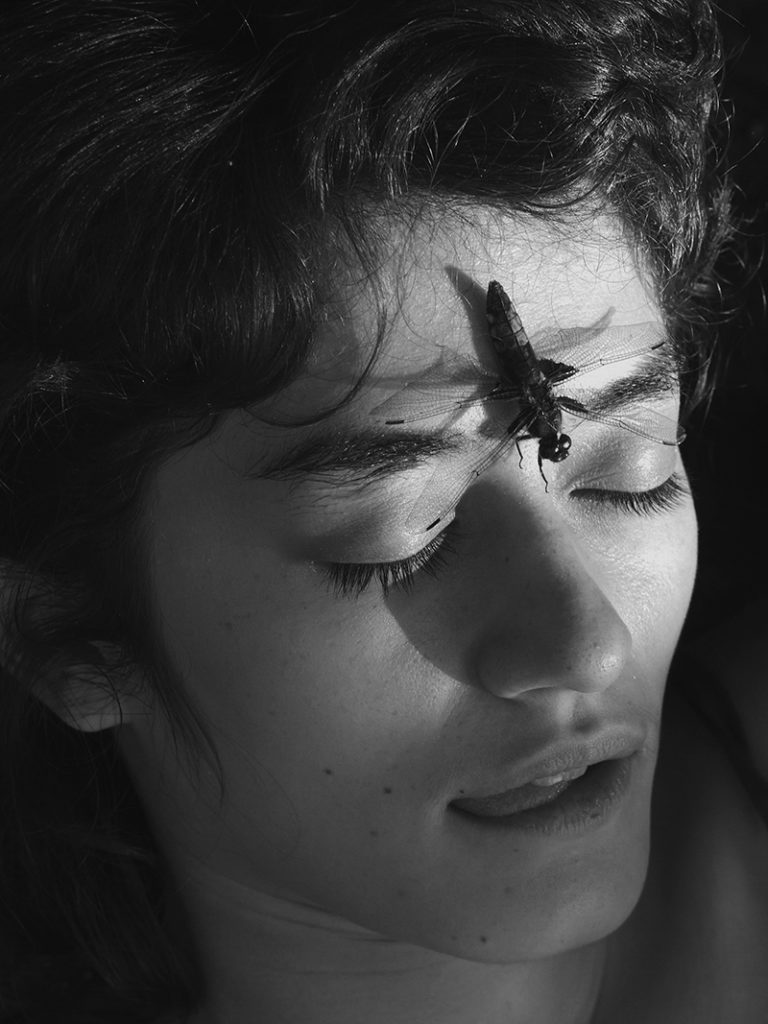Chloé Milos Azzopardi is a French photographer and artist. Based on her personal experience, she is interested in the relationship between human and non-human beings, trying to get out of the prism of utility and servitude. Her research focuses on the representation of mental health and the construction of post-capitalocene imaginaries.
To start us off, can you introduce yourself? How did you begin to make photographs? Where did you grow up and how did that environment shape you?
Hi ! My name is Chloé Milos Azzopardi, I’m a French artist and photographer. I grew up in the suburbs of Paris. When my mother was young , she studied photography for a year or two and then she stopped. She almost never talked about it, it was something very mysterious to me. Once she showed me some contact sheets and at my request she gave me one of her old silver prints. I hung it in the middle of my posters, it was a view of a staircase in Montmartre. I remember the pleasure I got from looking at the texture of the print and its brilliance, I had the impression that the blacks were liquid like water.
What were the key elements to your photographic education? I don’t just mean photographers and schools—I’m thinking of key life experiences or other forms of art.
I think there are three key elements.
The first one is when I started to take photos. I was 16 and I skipped high school a lot, I hid in parks, waiting for the day to end while watching people and nature. Most days were filled with boredom, so I would sometimes take a book or a small camera with me to kill time.
The second one is my practice of drawing and my research of colours. When I was 20 I was making large format drawings with small markers and I was taking photos to help me in the composition. After a few years, I came to a point where I realized I wasn’t making drawings anymore; I was making huge photos that I spent months developing with my markers instead. After I realized that my way of looking at my own photos changed.
The third one is when photography really got me. I was 23 and I went to China for my fourth year in art school. Photography was like a national sport there. People were stopping me in the street, in restaurants or in the subway so they could take a photo of me. I had always been too shy to take pictures of people or situations, but there, because everyone was taking photos of everything everyday, I felt more comfortable to shoot the life around me. I made my first photo exhibition in a small market in Shanghai, I had 60 photos in postcard format that I had shot in China. I proposed to the users of the market to choose a photo and to exchange it for what they wanted. I earned a lot of candies and food from the market, people also sent me photos they had on their phone. I never stopped photography after that.
Can you tell us more about the starting point of the ‘Forms they inhabit in Time of Crisis’?
The title comes from a text that I was writing three years ago. It was about a woman who could no longer leave her house and who contemplated her plants and objects to the point of merging with them. I started to make photos for this series without knowing what it was going to be. Like the woman in my story I couldn’t go out often because of the depersonalization I was experiencing. I was really afraid for my mental health at that time because I didn’t know what was happening to me. The pictures were like distractions, I had no idea they would talk about this.
I was particularly attached to this aspect of your project statement: “The distinction and hierarchy constructed between man and animal and between nature and culture seemed to me increasingly obsolete”. After all, art by its very nature challenges prevailing relationships and offers new suggestions. What implications would you like your project to develop?
Through my work I try to make people look at terrestrial life with the same curiosity and fascination they would have when discovering life forms from other planets.
I wish that we could feel the radical otherness of an animal without immediately entering into a relationship of domination with it, that we could recognize ourselves in this otherness. I wish we could feel that when we observe other living beings, we are also the observed, even if what is around us does not necessarily have eyes.
Western philosophy wanted so much to differentiate human beings from the animal and from the nature that we came to think that we were not part of the living things anymore, that we were something else. If my work can in some way question this separation between the human and the rest of the living things then I would be very happy.
Has photography contributed to the management of crises of dissociation and depersonalization? If so, how do you think it achieves this?
Yes, taking photos was a way to put something between me and reality, I just had to focus on the sensations my eyes were giving me and I was less overwhelmed by my environment. I realized maybe a year ago that my framing was very rigid, most of the time I needed my subject to be whole, in the center of the image and in the foreground, surrounded by straight edges with no other information entering the frame. With the depersonalization I had a hard time understanding the boundaries of my body and my environment, photography worked as a tool that allowed me to redraw the outline of things.
Now I try to get out of this rigidity, to make freer images, to control them less. I have learned not to fight with the crises anymore. I try to capture in a photo the blurred sensation of existing in a body without feeling it, of being absorbed in the movement of a leaf or in the look of another living being.
Have you ever thought that this work of yours has several self-referential elements of the medium of photography?
I have never thought about it, but I think I felt what you mean. Most of the time when I make photographs I feel like the subject is the photographic act itself.
I sometimes use a frame within a frame, but I think the most representative element of this self-reference is my relationship to the gaze. In my work, the eyes are they often in a viewfinder. This relationship to the gaze also exists when I photograph animals: most of the time they stare at me, they indicate my presence in the photo and therefore the action of photographing them. And in general, like many artists, I have a fascination with hands, as if capturing hands in action was a way to represent the act of creation.
There is not a specific shooting location in your project, which I think always gives a lot of freedom to the creator but also it may be challenging for the coherence of the work. How do you deal with that?
I’m struggling with that haha ! We are so used to find coherence through a given space and time that it is complicated to create a coherent world or ecosystem from many different places. For this series I try to build coherence in the sensations. To create links through what a body feels and does not feel physically. It’s an ongoing research and I like how it challenges me.
Can you speak more about the sequencing process?
It really depends on the project. Sometimes a series will work itself out, I’ll take a picture and feel what other pictures it needs, as if the pictures were mutually attracted to each other.
For this series, it’s more complicated. I printed out all the photos and the order keeps changing. I think the subject of the series has something to do with it. How do you give an order and limits to a series that speaks of a state of flux, of changing bodies, of loss of reference points and disappearing limits?
I am still looking for a sequencing that reflects the state of dissociation and depersonalization.
Do you intend to create a photobook for this series? Or do you prefer to present this project with prints in solo/group shows?
I like to do both, it’s a very different experience.
I’m currently working on a photo book, since I’m still looking for the right form for the whole project, I don’t know when it will exist.
In March 2022, I will have a solo show at the Hidden Gallery in Prague. I am very excited about it, I like to sculpt the space, to mix my photos with installations in order to create an atmosphere in which people can enter.
When was the first time you felt that you were achieving what you really want to do with photography?
When I shot the snake held by four hands. It was a difficult time because a tragedy had just happened in my family, I was exhausted and I was apprehensive to go see the person who was taking care of this snake because I had only met him once in the street. I almost cancelled the meeting. It was an achievement for me because I decided to go anyway, I already had the image in my head and I didn’t let it go. It was the first time I dedicated myself so much to a photo.
What are your next steps?
I want to finish that book haha.
More on her website














